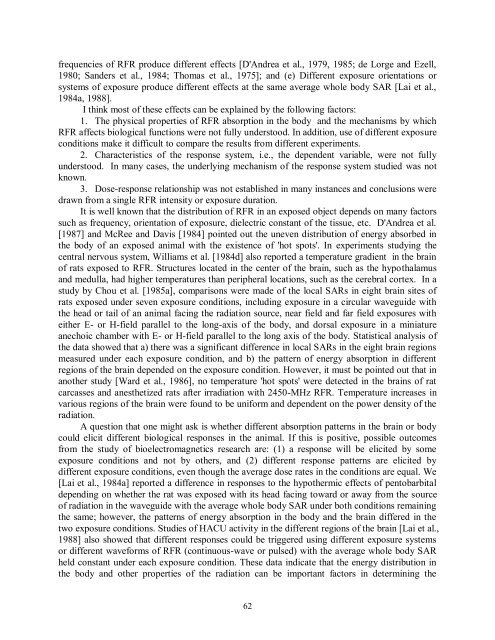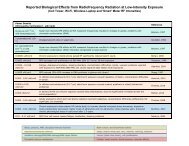Evidence for Effects on Neurology and Behavior - BioInitiative Report
Evidence for Effects on Neurology and Behavior - BioInitiative Report
Evidence for Effects on Neurology and Behavior - BioInitiative Report
You also want an ePaper? Increase the reach of your titles
YUMPU automatically turns print PDFs into web optimized ePapers that Google loves.
frequencies of RFR produce different effects [D'Andrea et al., 1979, 1985; de Lorge <strong>and</strong> Ezell,<br />
1980; S<strong>and</strong>ers et al., 1984; Thomas et al., 1975]; <strong>and</strong> (e) Different exposure orientati<strong>on</strong>s or<br />
systems of exposure produce different effects at the same average whole body SAR [Lai et al.,<br />
1984a, 1988].<br />
I think most of these effects can be explained by the following factors:<br />
1. The physical properties of RFR absorpti<strong>on</strong> in the body <strong>and</strong> the mechanisms by which<br />
RFR affects biological functi<strong>on</strong>s were not fully understood. In additi<strong>on</strong>, use of different exposure<br />
c<strong>on</strong>diti<strong>on</strong>s make it difficult to compare the results from different experiments.<br />
2. Characteristics of the resp<strong>on</strong>se system, i.e., the dependent variable, were not fully<br />
understood. In many cases, the underlying mechanism of the resp<strong>on</strong>se system studied was not<br />
known.<br />
3. Dose-resp<strong>on</strong>se relati<strong>on</strong>ship was not established in many instances <strong>and</strong> c<strong>on</strong>clusi<strong>on</strong>s were<br />
drawn from a single RFR intensity or exposure durati<strong>on</strong>.<br />
It is well known that the distributi<strong>on</strong> of RFR in an exposed object depends <strong>on</strong> many factors<br />
such as frequency, orientati<strong>on</strong> of exposure, dielectric c<strong>on</strong>stant of the tissue, etc. D'Andrea et al.<br />
[1987] <strong>and</strong> McRee <strong>and</strong> Davis [1984] pointed out the uneven distributi<strong>on</strong> of energy absorbed in<br />
the body of an exposed animal with the existence of 'hot spots'. In experiments studying the<br />
central nervous system, Williams et al. [1984d] also reported a temperature gradient in the brain<br />
of rats exposed to RFR. Structures located in the center of the brain, such as the hypothalamus<br />
<strong>and</strong> medulla, had higher temperatures than peripheral locati<strong>on</strong>s, such as the cerebral cortex. In a<br />
study by Chou et al. [1985a], comparis<strong>on</strong>s were made of the local SARs in eight brain sites of<br />
rats exposed under seven exposure c<strong>on</strong>diti<strong>on</strong>s, including exposure in a circular waveguide with<br />
the head or tail of an animal facing the radiati<strong>on</strong> source, near field <strong>and</strong> far field exposures with<br />
either E- or H-field parallel to the l<strong>on</strong>g-axis of the body, <strong>and</strong> dorsal exposure in a miniature<br />
anechoic chamber with E- or H-field parallel to the l<strong>on</strong>g axis of the body. Statistical analysis of<br />
the data showed that a) there was a significant difference in local SARs in the eight brain regi<strong>on</strong>s<br />
measured under each exposure c<strong>on</strong>diti<strong>on</strong>, <strong>and</strong> b) the pattern of energy absorpti<strong>on</strong> in different<br />
regi<strong>on</strong>s of the brain depended <strong>on</strong> the exposure c<strong>on</strong>diti<strong>on</strong>. However, it must be pointed out that in<br />
another study [Ward et al., 1986], no temperature 'hot spots' were detected in the brains of rat<br />
carcasses <strong>and</strong> anesthetized rats after irradiati<strong>on</strong> with 2450-MHz RFR. Temperature increases in<br />
various regi<strong>on</strong>s of the brain were found to be uni<str<strong>on</strong>g>for</str<strong>on</strong>g>m <strong>and</strong> dependent <strong>on</strong> the power density of the<br />
radiati<strong>on</strong>.<br />
A questi<strong>on</strong> that <strong>on</strong>e might ask is whether different absorpti<strong>on</strong> patterns in the brain or body<br />
could elicit different biological resp<strong>on</strong>ses in the animal. If this is positive, possible outcomes<br />
from the study of bioelectromagnetics research are: (1) a resp<strong>on</strong>se will be elicited by some<br />
exposure c<strong>on</strong>diti<strong>on</strong>s <strong>and</strong> not by others, <strong>and</strong> (2) different resp<strong>on</strong>se patterns are elicited by<br />
different exposure c<strong>on</strong>diti<strong>on</strong>s, even though the average dose rates in the c<strong>on</strong>diti<strong>on</strong>s are equal. We<br />
[Lai et al., 1984a] reported a difference in resp<strong>on</strong>ses to the hypothermic effects of pentobarbital<br />
depending <strong>on</strong> whether the rat was exposed with its head facing toward or away from the source<br />
of radiati<strong>on</strong> in the waveguide with the average whole body SAR under both c<strong>on</strong>diti<strong>on</strong>s remaining<br />
the same; however, the patterns of energy absorpti<strong>on</strong> in the body <strong>and</strong> the brain differed in the<br />
two exposure c<strong>on</strong>diti<strong>on</strong>s. Studies of HACU activity in the different regi<strong>on</strong>s of the brain [Lai et al.,<br />
1988] also showed that different resp<strong>on</strong>ses could be triggered using different exposure systems<br />
or different wave<str<strong>on</strong>g>for</str<strong>on</strong>g>ms of RFR (c<strong>on</strong>tinuous-wave or pulsed) with the average whole body SAR<br />
held c<strong>on</strong>stant under each exposure c<strong>on</strong>diti<strong>on</strong>. These data indicate that the energy distributi<strong>on</strong> in<br />
the body <strong>and</strong> other properties of the radiati<strong>on</strong> can be important factors in determining the<br />
62



